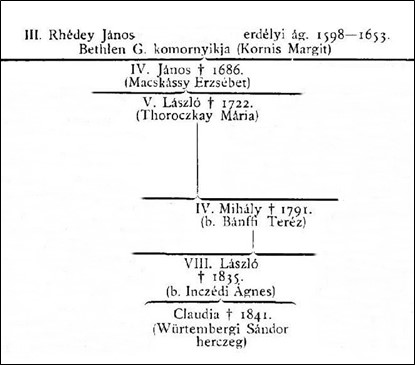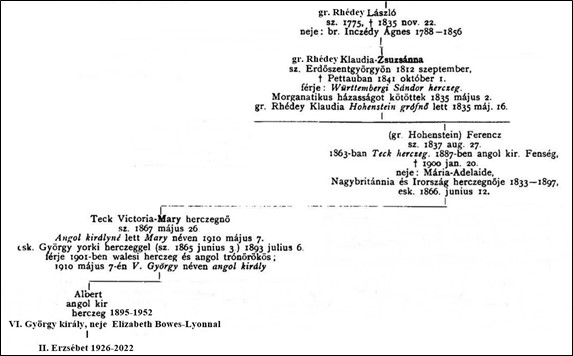Rhédey- bloodline in the English royal family
The origins of the Rhédey family [1] are not sufficiently clear, but they claim to be descended from the Aba clan. This tradition is not fully proven.
Iván Nagy stated it as fact in his famous genealogical work. [2] However, András Komáromy (1861-1931), historian, archivist and corresponding member of the Hungarian Academy of Sciences, expressed doubts about this. He was the person who compiled the family genealogy while organising the Rhédey archives in the library of the Hungarian National Museum. He published his findings in 1883. [3] We shall also rely on his work.
Komáromi assumed that a clan - which could have been descended from the Abas - started to use the name Rédei after the location of their Heves county estates in several settlements with the suffix, Rédei. The clan later divided into seven families. The men of these families already played significant roles in the history of our country during the life of King Matthias.
The family we are interested in comes from Mikó of Kisréde and Szentmártonréde, who lived in the last decades of the 13th century. István Rhédey (1598-1645), Viceroy of Szepes County, and his descendants constitute the Hungarian branch. János Rhédey (1598-1653) and his descendants form the Transylvanian branch.
János Rhédey was brought up at the court of Gábor Bethlen, Prince of Transylvania, and entered his service in 1614. Around 1628, he married Margit, the eldest daughter of Ferenc Kornis, chief royal magistrate of Szentpál and Judit Bornemisza of Kápolna. He received the Homoródszentpál and Erdőszentgyörgy manors as a dowry, the deed of which was issued by Gábor Bethlen in 1629 in Fogaras. Their youngest son János lived on the estate of Erdőszentgyörgy and married Erzsébet Macskássy. The son of their elder son, László and Mária Thoroczkay, János followed a military career, becoming major in 1754, general in 1765, and then first lieutenant in the Hungarian noble guard of Maria Theresa. His brother Mihály inherited his huge monetary assets, as he had no children. One of Mihály’s and Baroness Teréz Bánffy's sons, László, married Baroness Ágnes Inczédi. They had only one child, a daughter called Klaudia Rhédey. The children of László Rhédey and Mária Thoroczkay were ennobled to the rank of counts in 1744 with the noble name of Kis-Rhédei. Thus, their descendants, including Klaudia Rhédey, were also granted this title.

Born in 1812, Countess Klaudia-Zsuzsánna Rhédey of Kis-Rhéde was married to Duke Alexander of Württemberg in 1835. The Countess died in an accident in 1841. Her name might well have been forgotten had the press not made a sensational discovery in December 1891 in connection with a British royal engagement. As it happened, the first-born son of Prince Clarence of Wales, heir to the British throne was betrothed to Princess Victoria-Mary Teck, daughter of Prince Francis Teck and Mary Adelaide, Princess Royal of England. The young princess was none other than the granddaughter of Countess Claudia Rhédey.[4]
Let us return to 1812. It was on 21 September[5] that Klaudia-Zsuzsánna, the daughter of Count László Rhédey of Kis-Rhéde and Baron Ágnes Inczédi, was born. According to memoirs and literature, the most beautiful Transylvanian woman was married on 2 May 1835 to Prince Alexander of Württemberg, an Austrian Imperial Hussar colonel. Their marriage was a morganatic marriage[6] and Klaudia was not allowed to assume her husband's titles. According to a contemporary report: 'The marriage of His Royal Highness, Prince Alexander of Württemberg, colonel of the Hussar regiment of Franz Joseph I of Austria, brother of the Queen of the Württemberg to Countess Claudia Rhédey, a Transylvanian-born countess, a young lady of not only external beauty but also of high spiritual standing, took place in Vienna on 2 May. His Imperial Majesty the Blessed Francis I, shortly before his death, bestowed on the bride the name of Countess Hohenstein, which she, as the wife of the royal prince, will bear, and the offspring born of the marriage will also inherit this name."[7] They had three children, Countess Claudine, Count Francis and Countess Amalia of Hohenstein.
Their mother, Klaudia Rhédei, died on 1 October 1841 in Pettau, Styria. According to László Kővári, whose data were taken over by Iván Nagy, she had an accident at a military inspection in Vienna, where she fell from her horse.[8] According to the memoirs of László Kozma, the lawyer of the Rhédey family, "The family was delayed on the return journey after their stay in Erdőszentgyörgy. The Prince rode ahead with his aide-de-camp, the family travelled in a carriage, lagging behind. Due to the coachman's carelessness, they fell into a ditch. The children were unharmed, but the Countess, halfway through her pregnancy, suffered a painful blow. On arriving in Graz at the suggestion of her friend to surprise their husbands in Pettau, they rode for another eight hours the next day. The morning after their arrival, the Countess was unable to get out of bed and died eight days later. On 21 October 1841, she was buried in the Reformed Church in Erdőszentgyörgy, in the ancient burial vault of the Count Rhédey family."[9]

In 1863, the three Hohenstein children were granted the title of Duke of Teck by their father's cousin, King William of Württemberg, and thus rose in rank to the top of the European royal families. Presumably one of the reasons for this was that three years later, in 1866, Francis was to marry Mary Adelaide (1833-1897)[10], Duchess of Cambridge. Later, Queen Victoria[11] also recognised Francis Hohenstein as the rightful holder of the title of Duke of Teck and in 1886 he was made a royal highness of England. They had four children together, Victoria-Mary, Adolf, Franz and Alexander of Teck.[12]
This brings us to the engagement of Prince Clarence and Princess Victoria-Mary Teck in December 1891. This never became a marriage, as the groom had died before the event. So Prince Clarence's younger brother, Prince George of York (1865-1936)[13], betrothed the grieving bride in April 1893 and married her on 6 July. The husband ascended the throne on 6 May 1910 as George V, and his wife became Queen of the United Kingdom and the British Dominions and Empress of India under the name of Mary. They had five sons and one daughter, Edward-Albert in 1894, Albert in 1895, Victoria-Alexandra in 1897, Henry in 1900, George in 1902 and John in 1905.[14]
After the death of George V, his first-born son Edward-Albert succeeded to the throne as Edward VIII. In the same year he abdicated and his younger brother Albert was crowned, who reigned as George VI. The latter was succeeded on the throne by his elder daughter Elizabeth II after his death in 1952.
Elizabeth II's great-grandmother was a Hungarian countess, Count Klaudia Zsuzsanna Rhédey, and her great-great-grandfather was a Hungarian count, Count László Rhédey. Thus, the fifth ascendant of the new king, the great-great-grandmother of Charles III, was a Hungarian countess, and his sixth ascendant was a Hungarian count.
Literature
Komáromy 1883. Komáromy András: A kis-rédei gróf Rhédey családról. Turul, 1. (1883) 119–138.
Komlóssy 1910. Komlóssy Artúr: Az angol királyné magyar rokonsága. Turul, 28. (1910) 97–99.
Kozma 1909. Kozma Ferenc (közli): Gróf Rhédei Claudin herceg Würtemberg Sándorné végső napjai. (Halálos útja Erdélyből Pettauba és vissza.) Erdély. Honismertető folyóirat, 18. (1909) 1–2. sz. 45–48.
Kővári 1854. Kővári László: Erdély nevezetesebb családai. Kolozsvár, 1854.
Marcziányi 1891. Marcziányi György: Eljegyzés a brit királyi házban. Vasárnapi Ujság, 38. (1891) 51. sz. 849–850.
Nagy 1862. Nagy Iván: Magyarország családai czímerekkel és nemzékrendi táblákkal. IX. kötet. Pest, 1862.
[1] Names are spelled according to today's spelling, aiming to keep the original form.
[2] Nagy 1862, 742.
[3] Komáromy 1883.
[4] Marcziányi 1891, 849.
[5] Komlóssy 1910, 98. Other sources mention a different date in September.
[6] Morganatic marriage: a legal marriage, but limited by civil law, where the woman does not obtain her husband's rank, title, privileges, and the offspring neither inherit them from the father.
[7] Jelenkor, 3. June 1835. 355.
[8] Kővári 1854, 215.
[9] Kozma 1909, 47.
[10] Princess Mary Adelaide Wilhelmina Elizabeth of Cambridge, Duchess of Teck
[11] Queen Victoria (1837–1901).
[12] Princess Victoria Mary of Teck, Prince Adolphus of Teck, Prince Francis of Teck, Prince Alexander of Teck
[13] Prince George, Duke of York, később: George V.
[14] Edward VIII, George VI, Victoria Alexandra Alice Mary, Prince Henry, Prince George, Prince John.